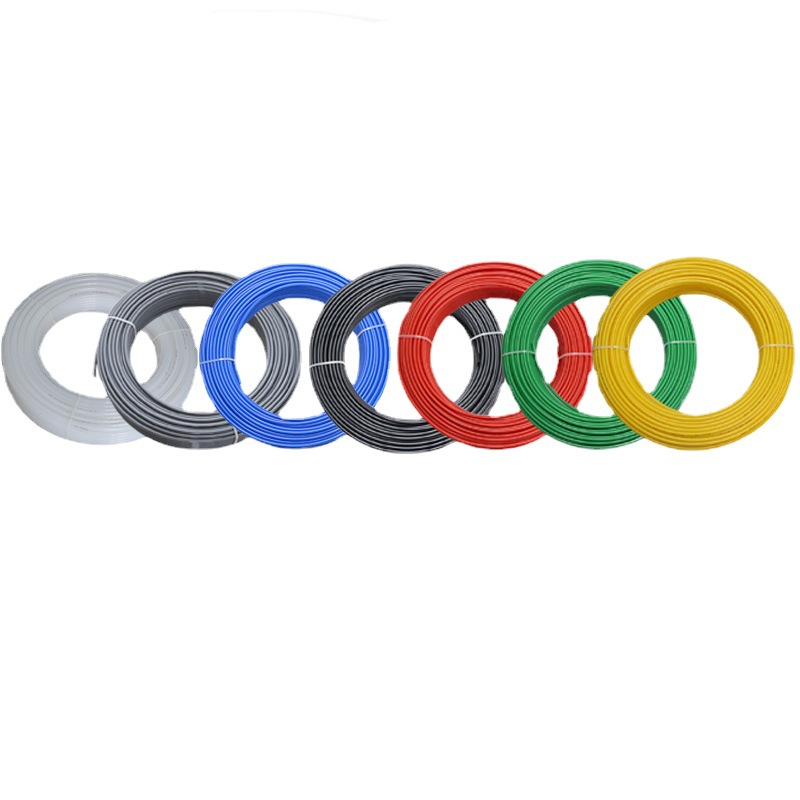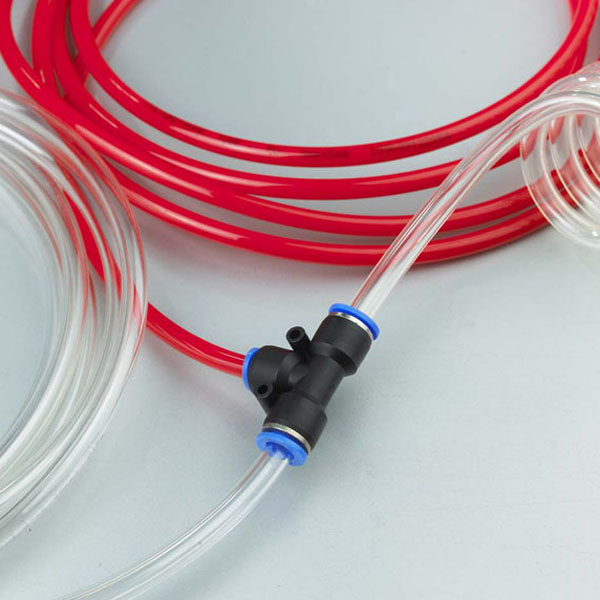In the dynamic world of pneumatic systems, the choice of materials plays a crucial role in ensuring operational efficiency and reliability. Among the various materials available, PU tubes, or polyurethane tubes, have emerged as a preferred option for many industries. These tubes are known for their exceptional flexibility, durability, and resistance to harsh environmental conditions.

I. Understanding PU Tubes
PU tubes are flexible tubes made from polyurethane, a versatile polymer that exhibits excellent mechanical properties. The manufacturing process typically involves the extrusion of polyurethane, allowing for the creation of tubes with varying diameters and wall thicknesses tailored to specific applications. The unique composition of polyurethane provides PU tubes with characteristics that set them apart from other materials.
When comparing PU tubes to other types of tubes, such as PVC (polyvinyl chloride) and rubber, several distinctions become apparent. While PVC tubes are often more rigid and less durable, rubber tubes may not offer the same level of chemical resistance. PU tubes combine the best features of both materials, making them an ideal choice for a wide range of applications. Their ability to withstand extreme temperatures and pressures further enhances their appeal in industries where reliability is paramount.
In summary, PU tubes are a critical component in pneumatic systems, offering flexibility and durability that are essential for efficient operation. Understanding their composition and manufacturing process is vital for making informed decisions when selecting materials for specific applications.

II. Key Features of PU Tubes
PU tubes are characterized by several key features that make them suitable for various applications.
1. Flexibility and Durability
One of the standout characteristics of PU tubes is their remarkable flexibility. Unlike rigid materials, PU tubes can bend and twist without breaking, making them ideal for dynamic applications where movement is required. This flexibility also contributes to their durability, allowing them to withstand repeated use in various environments without compromising performance.
2. Resistance to Abrasion and Chemicals
PU tubes are highly resistant to abrasion, oils, and a wide range of chemicals. This resistance ensures that they maintain their integrity even in harsh conditions, making them ideal for industrial applications where exposure to corrosive substances is common. The ability to resist wear and tear extends the lifespan of PU tubes, reducing the need for frequent replacements.
3. Temperature and Pressure Tolerance
Another significant advantage of PU tubes is their ability to operate effectively across a wide range of temperatures and pressures. This versatility allows them to be used in applications that require high performance under varying conditions, such as pneumatic systems and automotive components. PU tubes can typically handle temperatures ranging from -40°C to +80°C, depending on the specific formulation, and can withstand pressures up to 10 bar or more.
4. Lightweight Nature and Ease of Handling
The lightweight design of PU tubes makes them easy to handle and install. This characteristic not only reduces labor costs but also minimizes the risk of injury during installation and maintenance. The ease of handling is particularly beneficial in applications where long lengths of tubing are required, as it simplifies transportation and installation processes.
In conclusion, the key features of PU tubes—flexibility, durability, chemical resistance, temperature tolerance, and lightweight nature—make them an excellent choice for a variety of industrial applications. Understanding these features is essential for selecting the right tubing for specific needs.

III. What are the Main Uses of PU Tubes?
PU tubes are utilized across a diverse range of industries, each benefiting from their unique properties. Here are some of the primary applications:
1. Overview of Industries that Utilize PU Tubes
- Pneumatic Systems: PU tubes are commonly used in pneumatic systems for air and fluid transfer. Their flexibility and durability make them ideal for connecting various components, such as actuators, valves, and compressors. In these systems, PU tubes ensure efficient air transfer, contributing to the overall performance of automation systems.
- Automotive Applications: In the automotive sector, PU tubes are found in fuel lines, brake systems, and other critical components. Their resistance to fuels, oils, and chemicals makes them suitable for demanding automotive environments. For example, PU tubes are often used in fuel delivery systems, where they must withstand exposure to gasoline and other harsh substances.
- Food and Beverage Industry: Certain PU tubes are certified for food contact, making them suitable for transporting liquids in food processing and beverage production. Their non-toxic nature and resistance to bacteria ensure safe and hygienic transport of food products. Applications include beverage dispensing systems and food processing equipment. learn more about Food and Beverage Solution.
- Medical Equipment: PU tubes are also widely used in medical devices and equipment due to their biocompatibility and flexibility. They are commonly found in applications such as IV lines, catheters, and respiratory equipment, where safety and reliability are paramount. The ability to sterilize PU tubes further enhances their suitability for medical applications.
2. Specific Use Cases and Examples
For instance, in pneumatic systems, PU tubes are often used to connect actuators and valves, ensuring efficient air transfer. In the automotive industry, they can be found in fuel delivery systems, where their resistance to fuel and oils is essential for maintaining performance. In the food and beverage sector, PU tubes are used in bottling lines to transport liquids without contamination. In medical applications, PU tubes are critical for delivering fluids safely to patients.

IV. What are the Advantages of PU Tubes?
The advantages of PU tubes are numerous and contribute to their widespread use across various industries. Here are some key benefits:
- Enhanced Performance: PU tubes excel in various environments, providing consistent performance and reducing the likelihood of system failures. Their ability to withstand extreme temperatures and pressures ensures that they can operate effectively in demanding conditions, making them a reliable choice for critical applications.
- Cost-Effectiveness in the Long Run: Although the initial investment in PU tubes may be higher than other materials, their longevity and reduced maintenance costs make them a cost-effective choice over time. The durability of PU tubes means fewer replacements and less downtime, ultimately saving money for businesses.
- Safety and Compliance with Industry Standards: Many PU tubes meet stringent industry standards for safety and environmental compliance. This compliance provides peace of mind for users, knowing that the materials they are using are safe and reliable. In industries such as food and beverage and medical applications, compliance with safety standards is particularly crucial.
- Versatility: PU tubes can be manufactured in various sizes, shapes, and formulations, allowing for customization to meet specific application requirements. This versatility makes them suitable for a wide range of uses, from pneumatic systems to medical devices.
- Environmental Resistance: PU tubes are resistant to UV light, ozone, and other environmental factors that can degrade other materials. This resistance ensures that they maintain their performance and integrity over time, even when exposed to harsh conditions.
In conclusion, the advantages of PU tubes—enhanced performance, cost-effectiveness, safety compliance, versatility, and environmental resistance—make them an excellent choice for a variety of industrial applications. Understanding these benefits is essential for making informed decisions when selecting materials for specific needs.

V. How to Choose the Right PU Tube
Selecting the right PU tube for your application is crucial for ensuring optimal performance and reliability. Here are some factors to consider:

- Diameter and Length Requirements: Ensure the tube fits your specific application needs. The diameter and length can significantly impact performance, so it’s essential to choose the right size for your system.
- Working Pressure and Temperature Specifications: Check the tube’s ratings to ensure it can handle the required pressure and temperature for your application. PU tubes are available in various formulations, each designed to withstand different conditions.
- Compatibility with the Medium Being Transported: Make sure the PU tube is suitable for the type of fluid or gas it will transport. Compatibility is crucial to avoid degradation or failure of the tube over time.
- Environmental Conditions: Consider the environmental conditions in which the tube will be used. Factors such as exposure to UV light, chemicals, and extreme temperatures can affect the performance and lifespan of the tube.
- Regulatory Compliance: If the application involves food or medical use, ensure that the PU tube complies with relevant safety and regulatory standards. Certifications for food contact or biocompatibility are essential in these cases.
When sourcing PU tubes, look for reputable suppliers who provide detailed product specifications and certifications. Reading customer reviews and case studies can also help in making an informed decision. Additionally, consider suppliers that offer customization options to meet specific application requirements.
VI. Is the Installation and Maintenance of PU Tubes Difficult?
Proper installation and maintenance of PU tubes are essential for ensuring their longevity and performance, the installation and maintenance are easy. Here’s a step-by-step guide to help you with the process:
1. Step-by-Step Guide to Installing PU Tubes
- Preparation: Gather all necessary tools and materials before starting the installation process. This includes the PU tubes, fittings, cutting tools, and any other equipment required for the installation.
- Cutting: Use a sharp knife or tube cutter to cut the PU tube to the desired length. Ensure a clean cut to prevent leaks and ensure a proper fit with the fittings.
- Connecting: Use appropriate fittings to connect the tube to the system. Ensure a secure fit to avoid any air or fluid leaks. It’s essential to follow the manufacturer’s guidelines for the specific fittings used.
- Testing: After installation, conduct tests to check for leaks and ensure the system operates correctly. This step is crucial to identify any issues before the system is put into full operation.

2. Best Practices for Maintenance and Inspection
- Regular Inspections: Regularly inspect the tubes for signs of wear, damage, or degradation. Look for cracks, abrasions, or discoloration that may indicate a problem.
- Cleaning: Clean the tubes as needed to prevent the buildup of contaminants that could affect performance. Use appropriate cleaning solutions that are compatible with the tube material.
- Prompt Replacement: Replace any damaged sections promptly to maintain system integrity and prevent failures. Delaying replacement can lead to more significant issues down the line.
3. Common Issues and Troubleshooting Tips
If you encounter issues such as leaks or reduced flow, check for kinks or blockages in the tube. Ensure all connections are secure and that the tube is not exposed to excessive heat or pressure, which could lead to failure. If problems persist, consult the manufacturer or a qualified technician for further assistance.

In conclusion, proper installation and maintenance of PU tubes are essential for ensuring their longevity and performance. By following best practices and conducting regular inspections, you can maximize the lifespan and reliability of your PU tube systems.
VII. Conclusion
PU tubes are an essential component in various applications, providing flexibility, durability, and resistance to harsh conditions. Their unique properties make them suitable for a wide range of industries, including pneumatic systems, automotive applications, food and beverage processing, and medical equipment. For customers seeking reliable solutions in the pneumatic industry, PU tubes represent an excellent choice. By understanding their features, advantages, and proper installation and maintenance practices, you can make informed decisions that enhance the efficiency and reliability of your systems. If you have specific needs or require tailored solutions, feel free to contact us for high-quality PU tube products and expert advice. We are here to help you find the best PU tube solutions for your needs.

